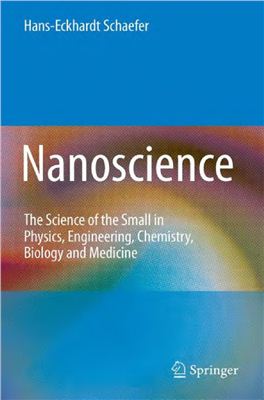Springer-Verlag, Berlin, 2010, 771 pages
Nanoscience stands out for its interdisciplinarity. Barriers between disciplines disappear and the fields tend to converge at the very smallest scale, where basic principles and tools are universal. Novel properties are inherent to nanosized systems due to quantum effects and a reduction in dimensionality: nanoscience is likely to continue to revolutionize many areas of human activity, such as materials science, nanoelectronics, information processing, biotechnology and medicine. This textbook spans all fields of nanoscience, covering its basics and broad applications. After an introduction to the physical and chemical principles of nanoscience, coverage moves on to the adjacent fields of microscopy, nanoanalysis, synthesis, nanocrystals, nanowires, nanolayers, carbon nanostructures, bulk nanomaterials, nanomechanics, nanophotonics, nanofluidics, nanomagnetism, nanotechnology for computers, nanochemistry, nanobiology, and nanomedicine. Consequently, this broad yet unified coverage addresses research in academia and industry across the natural scientists. Didactically structured and replete with hundreds of illustrations, the textbook is aimed primarily at graduate and advanced-undergraduate students of natural sciences and medicine, and their lecturers.
Nanoscience stands out for its interdisciplinarity. Barriers between disciplines disappear and the fields tend to converge at the very smallest scale, where basic principles and tools are universal. Novel properties are inherent to nanosized systems due to quantum effects and a reduction in dimensionality: nanoscience is likely to continue to revolutionize many areas of human activity, such as materials science, nanoelectronics, information processing, biotechnology and medicine. This textbook spans all fields of nanoscience, covering its basics and broad applications. After an introduction to the physical and chemical principles of nanoscience, coverage moves on to the adjacent fields of microscopy, nanoanalysis, synthesis, nanocrystals, nanowires, nanolayers, carbon nanostructures, bulk nanomaterials, nanomechanics, nanophotonics, nanofluidics, nanomagnetism, nanotechnology for computers, nanochemistry, nanobiology, and nanomedicine. Consequently, this broad yet unified coverage addresses research in academia and industry across the natural scientists. Didactically structured and replete with hundreds of illustrations, the textbook is aimed primarily at graduate and advanced-undergraduate students of natural sciences and medicine, and their lecturers.

